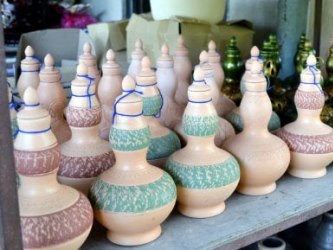Handicrafts

Malaysia boasts a delightful variety of traditional handicrafts. Choices range
from priceless authentic antiques to exquisite modern hand-made crafts.
As most artisans are Muslims, Malaysian handicraft designs are heavily
influenced by Islam. The religion prohibits the depiction of the human form in
art. Hence, most designs are based on natural elements such as the interlacing
of leaves or vines, flowers and animals.
EARTHENWARE
Popular items of traditional design include Perak's labu sayong, geluk, belanga,
Chinese dragon kiln ceramics and Sarawakian tribal motif pottery. Contemporary
items include vases, flower pots, decorative pottery, sculpture and kitchenware.
Labu Sayong
Labu Sayong is a black-coloured gourd-shaped clay jar typically used to store
and cool water. The state of Perak is renowned for this type of pottery.
Belanga
Found in many rural Malaysian homes, The belanga is often characterised by a
round base and wide rim. It is often used to cook curries, as it is believed
that its round base allows heat to be distributed more evenly.
Terenang
This angular-shaped jar is popularly used for storing water in the states of
Pahang and Terengganu. It has a concave neck and a convex body.
Wood Crafts
Blessed with an abundance of timber in boundless tropical forests, Malaysia is
renowned for an assortment of distinctive wood crafts. Traditionally, whole
houses were built from elaborate hand-carved timber. Today, antique Malay-styled
engraved panels, keris dagger handles, Chinese containers, unique Orang Asli
spirit sculptures, intricate walking sticks, kitchen utensils and carved scented
woods are among the wide range of exotic decorative items found in Malaysia.
Metal Crafts
Popular since the early days, traditional brass casting and bronze working are
still used to make an array of utensils. More recently in the 19th century, with
the discovery of tin in Malaysia, pewter has become increasingly popular. Metal
craft products include modern decorative items, kitchen ware and traditional
artifacts like tepak sireh sets, rose-water instruments and keris blades.
Hand-woven Crafts
Marvel at the creative hand-woven crafts of Malaysia. Local plant fibres and
parts from bamboo, rattan, pandan and mengkuang leaves are coiled, plaited,
twined and woven to produce items such as bags, baskets, mats, hats, tudung saji
and sepak raga balls.
TEXTILES
Colourful and captivating, Malaysia's traditional textiles are much sought after
worldwide. Varieties include batik, songket, pua kumbu and tekat. These textiles
are made into all sorts of decorative items, from haute couture clothes to
shoes, colourful curtains and delicate bed linen.
Batik
Referring to the process of dyeing fabric by making use of a resistant
technique; covering areas of cloth with wax to prevent it absorbing colours. The
colours in batik are much more resistant to wear than those of painted or
printed fabrics because the cloth is completely immersed in dye.
Songket
Utilising an intricate supplementary weft technique where gold threads are woven
in between the longitudinal silk threads of the background cloth. In the past,
this rich and luxurious fabric demonstrated the social status of the Malay
elite.
Pua Kumbu
Made from individually dyed threads on a back strap loom. Its supernatural
motifs are inspired by dreams and ancient animist beliefs. The patterns that
emerge are a fusion of the real and surreal. And each weave is distinctive of
its maker's hand.
Tekat
The art of embroidering golden thread onto a base material, generally velvet,
was traditionally used to decorate traditional Malay weddings regalia.
JEWELLERY & COSTUME ACCESSORIES
Enticing hand-crafted accessories abound in Malaysia. Choose from
leather-crafted goods, beadwork necklaces from Borneo or finely made gold and
silver jewellery adorned with gems.
Kerongsang
A three-piece brooch set traditionally used to pin the lapels of the baju kebaya
together. Kerongsang usually comes in sets of three. The typical three-piece set
comprises of a kerongsang ibu (mother piece) which is larger and heavier. The
other two are called the kerongsang anak (child pieces) and are worn below the
kerongsang ibu.
Cucuk Sanggul
A traditional hairpin used to secure hair in a bun at the back of women's heads.
Typically made of gold or silver, these hairpins are normally worn in graduated
sets of three, five or seven by brides and traditional dancers.
Pending
A large, intricately ornamented belt buckle worn around the samping, a
skirt-like cloth worn by men, to complement their baju melayu, the traditional
attire for men. Traditionally, the pending is a sign of wealth and status for
men.